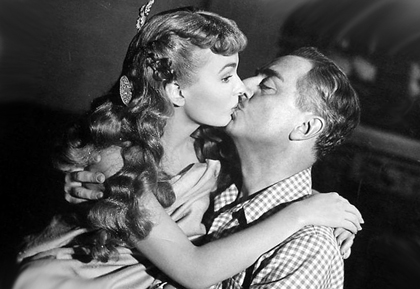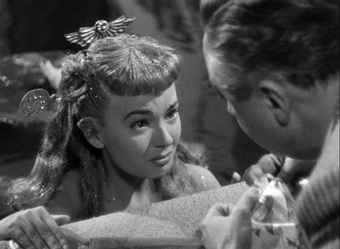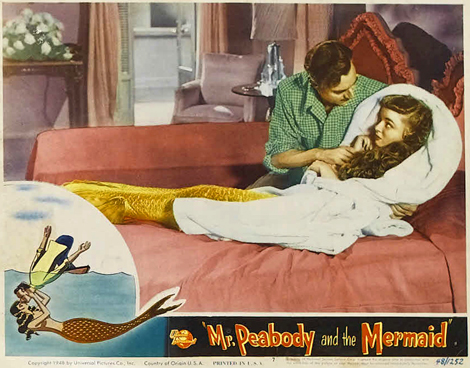|
|
Reviewed by Glenn Erickson
Critics writing about the postwar years insist that audiences rejected the candy-coated version of reality represented by the likes of Andy Hardy and demanded harder, more realistic entertainments. Dreamy optimism was out. Some of the best Hollywood talent was erring at the other extreme, making pictures too cynical to be believed. In 1948 successful writer Nunnally Johnson tried independent producing for the second time with a little picture made of pure wishful thinking. His marvelous script addresses what later came to be known as the male mid-life crisis. Johnson was himself turning fifty years old. He apparently had some amusing personal thoughts about his situation, for his Mr. Peabody and the Mermaid reinforces its honest laughs with pointed insights. The whole movie is an expression of the diminished virility and impending mortality experienced by a fellow who finds he can no longer pretend that he's a young man.
There was no actor better qualified to play the role of Mr. Peabody than William Powell, who for 25 years had personified confident and attractive romantic leading men. Recovering from an illness, Bostonian Arthur Peabody (Powell) takes a vacation to the Caribbean island of St. Hilda. He feels rejuvenated until his wife Polly (Irene Hervey) tells him that the fact that he's turning fifty is a great thing: she'll no longer need to worry about him straying. Almost immediately Arthur hears a literal Siren's Song calling him to a tiny island just offshore. Thinking that the singer is another local tourist, Cathy Livingston (Andrea King of Red Planet Mars), Arthur accosts her at a beach party and asks her to sing. The adventurous Cathy believes he's hitting on her, while Polly becomes a romantic target for Major Ronald Hadley (Hugh French), a local Brit law official. The next day Arthur snags and nets a real mermaid that he names Lenore (Ann Blyth). Lenore can't talk but they soon develop an irresistible mutual crush. Nobody believes Arthur or even bothers to look when he says Lenore is living in the large pond attached to his rented house. Polly sees just enough to mistake the aquatic Lenore with Cathy Livingston, and disappears. Not much later, Major Hadley suspects Arthur of homicide. But Mr. Peabody is happily serving breakfast to his live-in (swim-in?) dream lover.

As a comedy thriller Mr. Peabody and the Mermaid bears an immediate comparison to Ken Annakin's British production Miranda, which was released a few months earlier the same year. Miranda's mermaid (Glynis Johns) talks cultured English. She has an agenda of her own -- she wants to spawn with a 'beautiful' man and has plenty of tricks to make sure that various wives and girlfriends don't get in her way. The very funny movie satirizes the way English society indulges its straying, immature husbands.
The American-made Mr. Peabody is very much into the '40s craze for psychology. The story is told in flashback from an office in snowbound Boston, as a fascinated psychologist (Art Smith) listens to Arthur's fish tale. The comedy element is there, as Peabody carries his prize catch around, puts her in his wife's bathtub and finally into the pond. The impressive underwater set is 40 feet deep and has a decorative castle at the bottom, ready and waiting for Lenore to take up residence. Besides Polly Peabody's comic reaction to Lenore, we get the spectacle of Arthur in town trying to buy just the top half of a bathing suit, for 'modesty's sake'. Even better is the participation of character actor Clinton Sundberg as Mike, the public relations man. Mike is demoralized by the fact that his doctor has forbidden him to smoke. As he no longer cares what happens, Mike knowingly facilitates Arthur's meeting the mantrap Cathy Livingston. He eventually turns rat, prying secrets out of our mermaid-lover for Major Hadley. In a delicious parody of characters given 'psychological' reasons to go bad, Mike casually tells Arthur that he was really an upstanding nice guy until he quit alcohol. Now he's an SOB and no longer cares what rotten things he does.
We're properly amused by the script's jokes about straying husbands and catching a big fish. But it makes sense that the comic highlight in this movie about passive, defeated men would be a rivalry between women. Lenore hisses like a snake at the sight of Cathy Livingston. When the woman plunges into the pond to see for herself what kind of creature is hidden below, an underwater fight breaks out. Arthur is very much the stooge male caught between three strong females. The erotic mystery phantom wins out over both the sensible spouse and the reckless interloper. The only proof we have that Arthur has left his dream girl behind is that he eventually gives Lenore's elegant comb to Polly, without explanation. The censors need not worry, as the moral situation is thus neatly resolved.

But more prominent than the film's comedy is its delirious amour fou angle. Although we experience her as a real live mermaid, Lenore may well be a figment of Arthur's romantic yearnings. Lenore stares at Arthur with adorable baby eyes and hangs on his every expression. She doesn't talk or understand English but can soon tell that he approves of her. In other words, she's the perfect fantasy woman for a man too weary or vulnerable to deal with a real woman. Arthur falls for this phantom in a basic, almost infantile way -- the creature adores him and that's all that matters. Life with Polly is good but there's all that faulty communication to wade through, especially when Polly doesn't seriously listen to what he's telling her. Lenore makes Arthur feel like a child again, falling in love for the first time.
We almost expect the psychologist to advise Arthur, "Go buy a sports car."
The key scene in Nunnally Johnson's screenplay sees Arthur discouraged by a sunset. The sky sings a birthday greeting to him, with the mocking reminder that he's now fifty years old. It's like a death sentence. That's only one hint that connects Peabody's mid-life crisis with death, or with the wish that one could hurry up and die before the romantic bubble bursts. 'Lenore' would seem to be a reference to E.A. Poe. Arthur's mad love for the mermaid is an effort to reach beyond the limits of life, like one of Poe's morbid heroes clinging to a dead lover. Also, there's no compromise on Lenore's part. She wants him and she doesn't seem aware that he can't live underwater. Arthur and Lenore end up hunted by the law, like Bonnie & Clyde. One second Arthur is planning to run away with Lenore to a hideout in the Florida Keys, and then he abandons all hope. Does he try to drown himself? The show leaves this detail unresolved, as the image blurs out of focus... 1
This may be the best-directed picture by Irving Pichel, known for his earlier acting roles and as the director of George Pal's first two feature productions. It's just flawless. The relaxed pace seems to fit William Powell's moods. The close-ups of gorgeous Ann Blyth almost make one forget her more famous role as Joan Crawford's monstrous daughter in Mildred Pierce.

Mr. Peabody and the Mermaid begins by looking at snow falling. It then dissolves to a trip to the sunny Caribbean that reminds us a bit of RKO/Val Lewton's I Walked with a Zombie. The parallels with David O. Selznick's romantic fantasy Portrait of Jennie are even more pronounced. Both heroes fall in love with 'impossible' women that nobody else gets a clear look at. Each leaves a physical token (scarf, comb). The men are disillusioned and passive, and energized by a romance they know to be insane. In neither film is there much coherent communication, surely because too much talk would break the romantic spell. An older woman may have inspired one of the lovers, and the other lover is desperate to renew contact with his younger, carefree self. Both men rush off in sailboats to lonely islands in an effort to prolong their impossible relationships. Both men are "drowned" in the company of their phantom lovers, yet survive. 2
Each relationship has its own haunting musical theme, sung by the 'magical' female object of desire. In Mr. Peabody the music is a literal Siren's Song, perhaps to attract a lover. In Spanish, the word for mermaid is sirena.
Olive Films' Blu-ray of Mr. Peabody and the Mermaid is an excellent transfer of an original element. Contrast and sharpness are fine, allowing us to see the detail work that makes Lenore's hair appear to gleam and sparkle -- did they glue glass beads into her hair? The transfer has its share of fine scratches and flecks of dirt, which are heavy around one reel change near the end. But most of the presentation is very clear, and far more attractive than old television prints. The cover art for the disc may be Olive's most beautiful to date.

Russell Metty's camerawork can't be improved upon, and the film's sets seem designed to bring out a slightly ethereal, timeless quality. Peabody's rental house looks like some kind of quasi-classical location, with long white steps to the boat dock. Perhaps it was revamped from one of Universal's Arabian Nights movies? Special effects cameraman David Horsley filmed all of the rear projection plates in Florida, including the underwater scenes in the amazingly clear waters of credited Weeki Wachee Springs.
We're also impressed by two or three shots that incorporate rear projection into large sets. William Powell's double walks up from the surf as seen through the large window of a beachside bar. The beach exterior part of the image is a rear-projected process plate. When the double walks left behind part of a wall, the real William Powell takes his place in the live set, and ambles over to the bar while still drying himself off. Very clever.
On a scale of Excellent, Good, Fair, and Poor,
Mr. Peabody and the Mermaid Blu-ray rates:
Movie: Excellent
Video: Very Good
Sound: Excellent
Audio: English
Supplements: none
Deaf and Hearing Impaired Friendly?
No; Subtitles: None
Packaging: Keep case
Reviewed: June 24, 2014

Footnotes:
1. When we last see Lenore, it looks like she's dragging Arthur down to his doom, behind an underwater rock. It's visually similar to the endings of the first two Creature movies, made six years later. Was Nunnally Johnson leaving things open for a possible sequel?
The Creature films were also produced at Universal, and judging by the craftsmanship and artistry in Lenore's fish tail, I'd say that the Universal makeup department learned a lot of things that later helped them craft the superb Gill Man costume. Makeup artist Craig Reardon confirms that the tail was sculpted by Charles Gemora in the Universal lab:
Gemora nailed it. Those parallel groove details in the mermaid's fan-like tail are deceptively hard to achieve. That tail, and I don't mean a replica, but the very same tail that Ms. Blyth wore in the film, still hung on an old hanger in a closet in the Universal makeup lab when I briefly worked there the end of 1977. I didn't realize it at the time. I wish I'd taken a photo of it. It was still painted with the bright "goldfish" golden color it was given in 1948. Of course, gold paint is actually powdered brass. The brass had tarnished over the years and the tail had a brownish look accordingly. It was amazingly small. But, so was Ms. Blyth!" -- Craig
(in photo, left to right: Bud Westmore, Ann Blyth, Jack Kevan) Return
2. Writer John Patrick Shanley summed up the whole mid-life crisis / philandering / mortality issue in two or three funny lines in his great picture Moonstruck. Rose (Olympia Dukakis) corners her prospective son-in-law Johnny Cammareri (Danny Aiello) and buttonholes him with a direct query: "Why would a man need more than one woman?" Johnny answers, "I don't know. Maybe because he fears death." Rose is struck by the simple, clear truth of it all: "That's it! Thank you! Thank you for answering my question!"
Return

Text © Copyright 2014 Glenn Erickson
See more exclusive reviews on the Savant Main Page.
Reviews on the Savant main site have additional credits information and are often updated and annotated with footnotes, reader input and graphics.
Return to Top of Page
|

